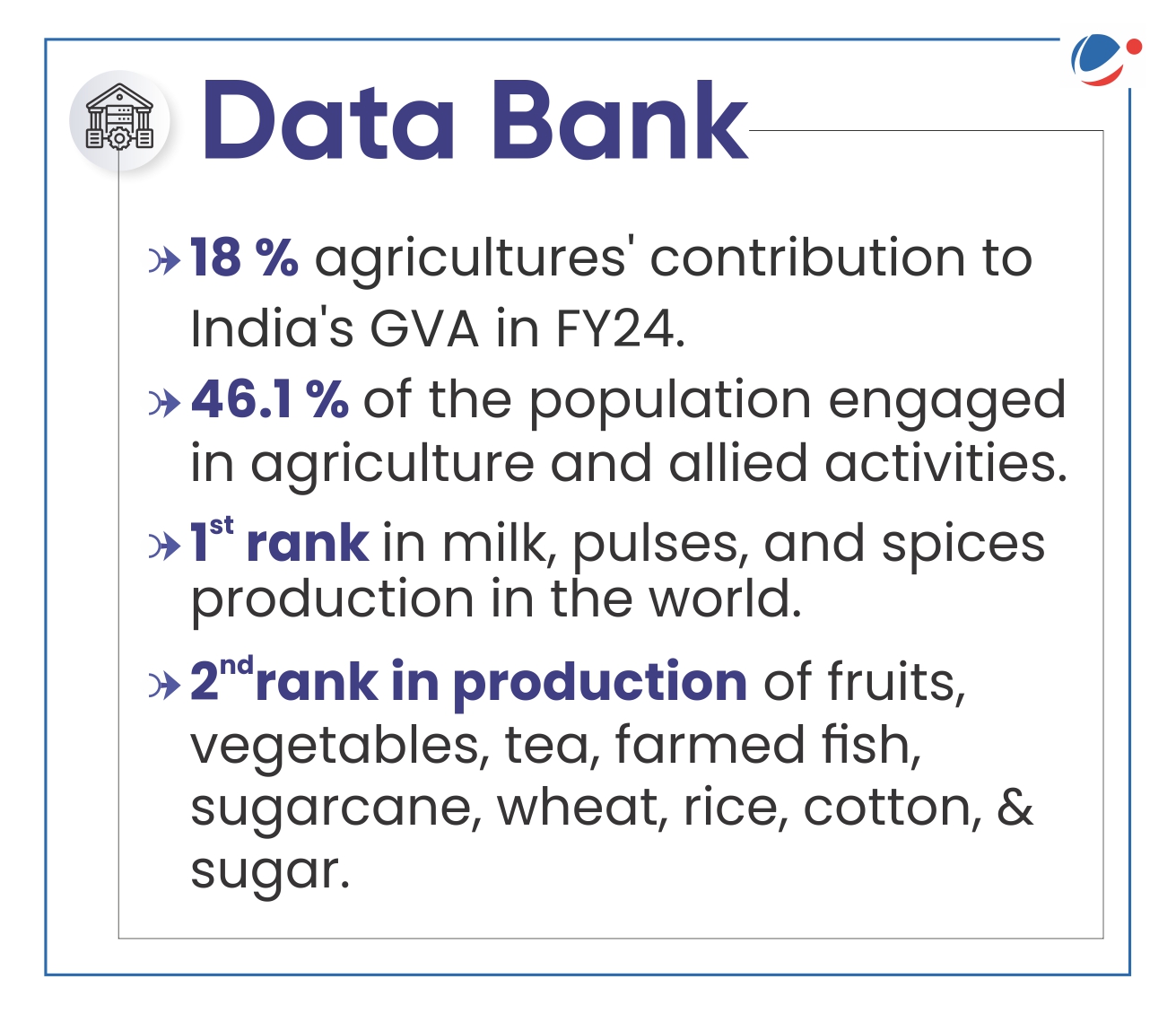Why in the news?
Aspirational Districts Programme (ADP)
|
Finance Minister announced the launch of the Prime Minister Dhan-Dhaanya Krishi Yojana (PMDKY) in the Union Budget 2025.
About Prime Minister Dhan-Dhaanya Krishi Yojana (PMDKY)
- Coverage: It will cover 100 districts based on 3 broad parameters: low productivity, moderate crop intensity, and below-average credit parameters.
- Cropping intensity is a measure of how efficiently land is used, and it is defined as number of crops grown on the same field during a given agricultural year.

- At the all India level, the cropping intensity was recorded at 155% in 2021-22 (Ministry of Agriculture).
- Inspired by ADP: It will be on the line of Aspirational Districts Programme (ADP), which was launched in 2018.
- Outlay: Budget documents do not provide a separate allocation for the scheme.
- Implementation Strategy: The program will be executed in partnership with state governments, focusing on the convergence of existing schemes.

Agriculture in India
- Backbone of India's economy: Agriculture plays a pivotal role in ensuring food security, providing employment, and contributing to overall economic development.
- Agricultural production and yield: Despite high level of production i.e 329.7 million tonnes for FY23, agricultural yield is found to be lower in most crops compared to other countries like China, Brazil & US.
- Example: India's rice yield stands at 2,191 kg per hectare, compared to the global average of 3,026 kg per hectare. Wheat yield in India is 2,750 kg per hectare, lower than world average of 3,289 kg per hectare.
Key Reasons for Low Agricultural Productivity
- Small and Fragmented Landholdings: The average farm size in India is only 0.74 hectares in 2021-22 (NABARD), leading to inefficiencies in farming operations.
- Fragmentation makes mechanization and irrigation difficult, reducing overall productivity.
- Dependence on Monsoons: Nearly 51% of India's farmland depends on rainfall rather than irrigation.
- Poor Irrigation: Percentage of net un-irrigated area over net area sown in the country is estimated to be about 48.65%.
- It is estimated that 40% of the net sown area is expected to remain rainfed even after attainment of full irrigation potential of the country.
- Low Use of Modern Technology: Limited access to high-yield seeds, fertilizers, and advanced machinery restricts productivity.
- Soil Degradation & Overuse of Chemicals: Soil erosion, salinity, and loss of organic matter reduce agricultural output.
- Lack of Credit and Investment: Hardly 20% of the 12.56 crore small and marginal farmers have access to institutional credit.
Recent Initiatives to Increase Productivity of Agriculture
- National Food Security Mission (NFSM): Launched in 2007-08 to increase the production of rice, wheat, pulses, coarse cereals, and nutri-cereals sustainably.
- Pradhan Mantri Krishi Sinchayee Yojana (2015): For extending the coverage of irrigation 'Har Khet ko pani' & improving water use efficiency 'More crop per drop' in a focused manner.
- PM-KISAN (Pradhan Mantri Kisan Samman Nidhi): Launched in 2019, it is a Central Sector scheme providing ₹6000 per year in 3 equal installments to farmers as an income support.
- Agriculture Infrastructure Fund (2020-21): To mobilize a medium to long term debt financing facility for investment in viable projects for post-harvest management infrastructure and community farming assets.
- MSP Enhancement: Government has increased the MSP for all mandated Kharif, Rabi and other commercial crops with a return of at least 50% over all India weighted average cost of production from 2018-19.
- Kisan Credit Card Scheme: To provide farmers with easy access to affordable credit.
- In 2019, KCC scheme was expanded to include animal husbandry, dairying, & fisheries.
- Pradhan Mantri Fasal Bima Yojana (2016): Aims to provide insurance coverage to farmers for crop failure, stabilise farmers' income, and encourage farmers to adopt modern agricultural practices, etc.
- Nutrient based subsidy policy (2010): The policy was formulated with the objective of promoting a balanced use of N, P and K fertilizers.
Conclusion
Enhancing agricultural productivity is crucial for ensuring food security, rural development, and economic growth in India. By promoting modern irrigation, mechanization, high-yield seeds, and sustainable farming practices, India can bridge the productivity gap with global standards. Making markets easier to access, giving financial support, and educating farmers will further increase crop yields. A multi-dimensional approach, combining policy support, innovation, and rural infrastructure development, is essential for achieving higher yields, and a more resilient farming ecosystem in India.



